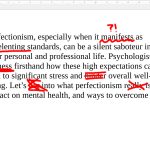Goal setting usually happens early in therapy and helps to focus clients and therapists. But what is a therapy goal, what are good therapy goals, why is it important to monitor them, and what are the pitfalls of goal-setting?
Table of Contents
Difference between therapy and life goals
In therapy, clients often have specific and tangible goals, like overcoming a particular fear, rather than broad, abstract aspirations, such as wanting to have a happy life. Interestingly, despite having specific goals, clients often feel farther away from their therapeutic goals than non-clients. The good news is that this is often a reflection of their long-standing struggles with a mental health problem, rather than an unrealistic goal.
While everyone has personal goals and dreams, therapy goals are often formed and refined through collaboration between the client and psychologist. Therapy clients often express avoidance goals, such as “I don’t want to stress about work”, or “I don’t want to be destructive any more”, while personal goals are often about obtaining something important, such as “I want a promotion at work”. As we will see later, avoidance goals are not great for therapy but can be turned into approach goals.
Why set goals together?
Research shows a positive relationship between goals created during client-therapist collaboration and psychotherapy outcomes (.33 correlation). This means that spending time together on setting goals early leads to positive outcomes of therapy.
Goal-setting time is helpful rather than wasteful.
In the context of psychotherapy with children and adolescents, collaboration often includes parents and caregivers. This adds complexity, especially when younger children might not fully understand the process of setting therapy goals. Regardless, research suggests that the participation of both parents and youth clients is related to better child/adolescent therapy outcomes.
Getting motivation from goals, avoiding frustration in therapy
Not all clients come to therapy with high motivation. Some are initially sceptical about the process or the therapist, and others might be there due to external pressures, such as from family members, rather than a personal choice. When clients actively participate in goal setting, it helps them to work towards their own objectives and increases their motivation for treatment. Oftentimes an initial external pressure (“You drink too much, you should go to therapy!”) can be turned into a meaningful personal goal (“I want to feel more comfortable and confident around people, so I don’t need to drink as much”).
Achieving agreement on goals is not always easy or even guaranteed. Research shows that agreement on the two most important goals between clients and their psychologists after their third session drops to only 1 in 3 cases (about 31.1% of the time). This means that both setting goals together and checking in with the goals regularly is important.
Misalignment in goals can lead to early dropouts.
When there is an agreement on goals between clients and therapists, the sessions are perceived as more positive and go smoother. At the same time, when there is a lack of agreement on goals, sessions are often described as superficial and less valuable, leading to difficulties with working towards outcomes, early dropouts, and frustration for both the client and the therapist.
Setting Therapy goals for the youth
Youths, especially children, often come to therapy because their parents bring them to. Therefore, their reasons for therapy are often different from their parents’. Studies suggest that 6 out of 10 children and their parents disagree on therapy goals (63%) when they are asked independently, and about 8 in 10 child-parent-therapist trio do not agree on the target problems initially (76.8%).
Most children, parents, and therapists would not agree on therapy goals unless time is spent on negotiating them.
At the same time, similarly to adults, collaborative goal-setting with children and adolescents has been found effective in building positive relationships with youth and family members, a step that cannot be skipped, even if the child initially came to therapy because of the parents.
Set goals early, monitor often
Collaborative goal-setting creates a roadmap for clients and psychologists, with a clear endpoint to work towards. When there is an early agreement between clients and therapists on treatment goals, better outcomes are likely.
There is also a positive relationship between monitoring the progress towards goals and therapy outcomes. Treatment should include goal monitoring, as it not only helps both the client and the psychologist to stay on track, but also leads to better mood, physical activity, and medication compliance, studies suggest.
Not all goals are equally helpful, but tracking is essential
For example, clients setting goals around depression have a better chance of succeeding (medium effect size) than around dieting and weight loss (small effect). Moreover, the way progress is monitored matters as well. Physical recording of goal progress, such as in a diary, leads to better outcomes compared to casual, unrecorded monitoring. The physical records help psychologists and their clients to reflect on their progress, promoting a sense of accountability and achievement.
Regarding goal types, avoidance goals, where clients want to avoid certain behaviours (“I don’t want to be harsh with myself”) lead to less positive outcomes. This is likely because avoidance goals create further distress in other ways (“I can’t believe I was harsh with myself again”). Clients with avoidance goals are generally less satisfied with their psychologist, show smaller increases in well-being, and perceive less improvement. The good news is that avoidance goals can often be rephrased as approach goals, aimed at increasing some other behaviours (“I want to be nicer to myself”), which are associated with more positive outcomes.
Intrinsic goals, which are inherently rewarding, are also linked to better outcomes, compared to extrinsic goals. Intrinsic goals include achieving things that are satisfying in themselves (“I want to learn how to paint because I enjoy it”), and often generating lasting motivation. On the other hand, extrinsic goals, created by some external pressure (“I want to learn how to paint so I can pass my exam”), are often less motivating, and the motivation fades quickly.
Setting realistic and attainable goals with intrinsic motivation, considering the nature of specific treatment goals, and monitoring the progress often can contribute to better therapeutic results.
Setting Realistic goals
Studies show that setting realistic expectations early in therapy is essential for client satisfaction and progress. This expectation-setting must happen early in therapy, sometimes as early as part of the informed consent.
With the help of the psychologist, who understands what change is possible given the client’s difficulties and research in that area, clients can choose their goals and rephrase them to be more realistic. For instance, regarding chronic depression, it might not be a realistic goal to “get rid of sadness and never feeling flat again”, but it could be rephrased to “learn to cope if my mood drops temporarily”.
Please note that this blog post by Personal Psychology is not intended to provide professional advice. If you or someone you know is experiencing mental health difficulties, it is important to seek help from a qualified healthcare professional.





